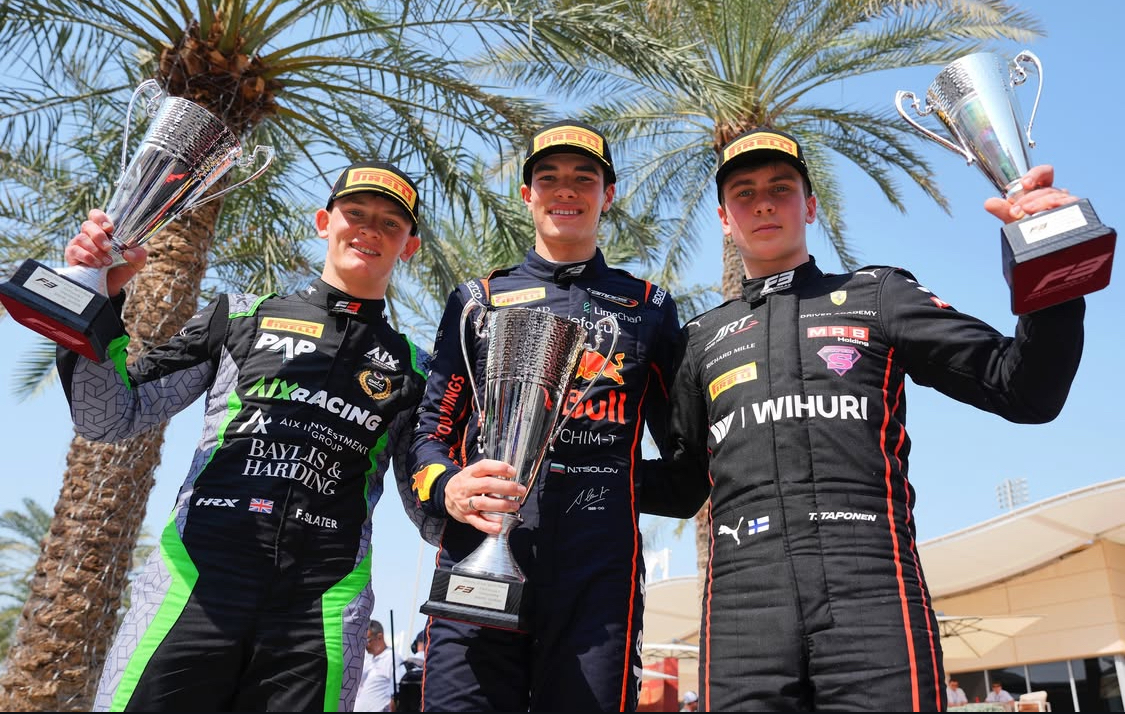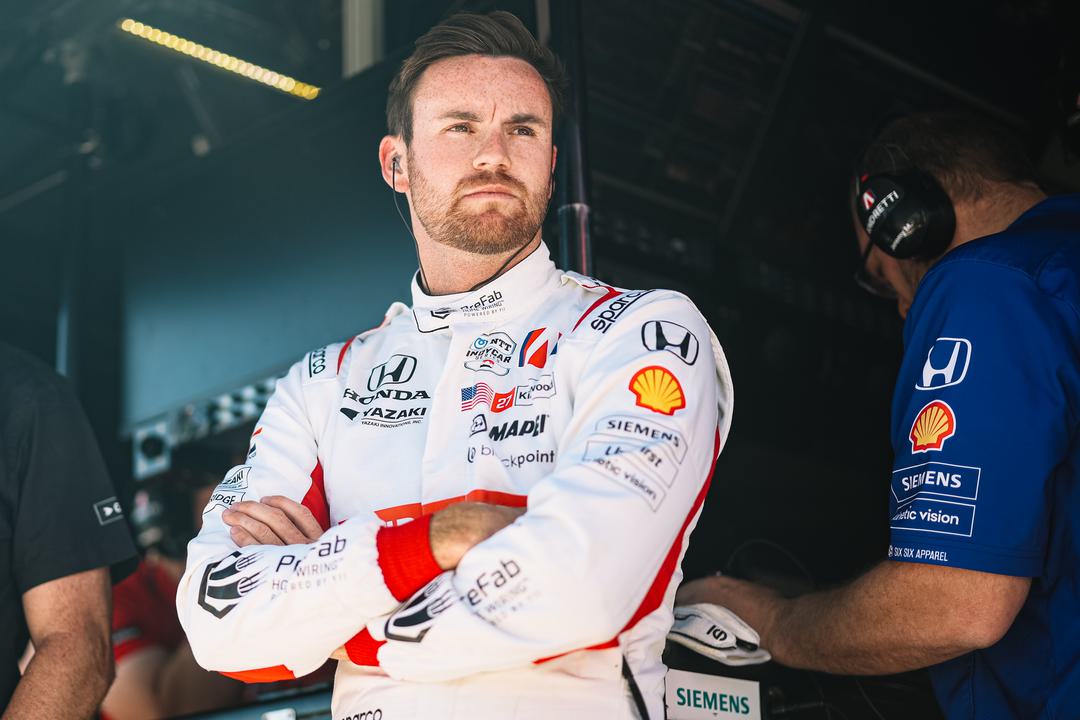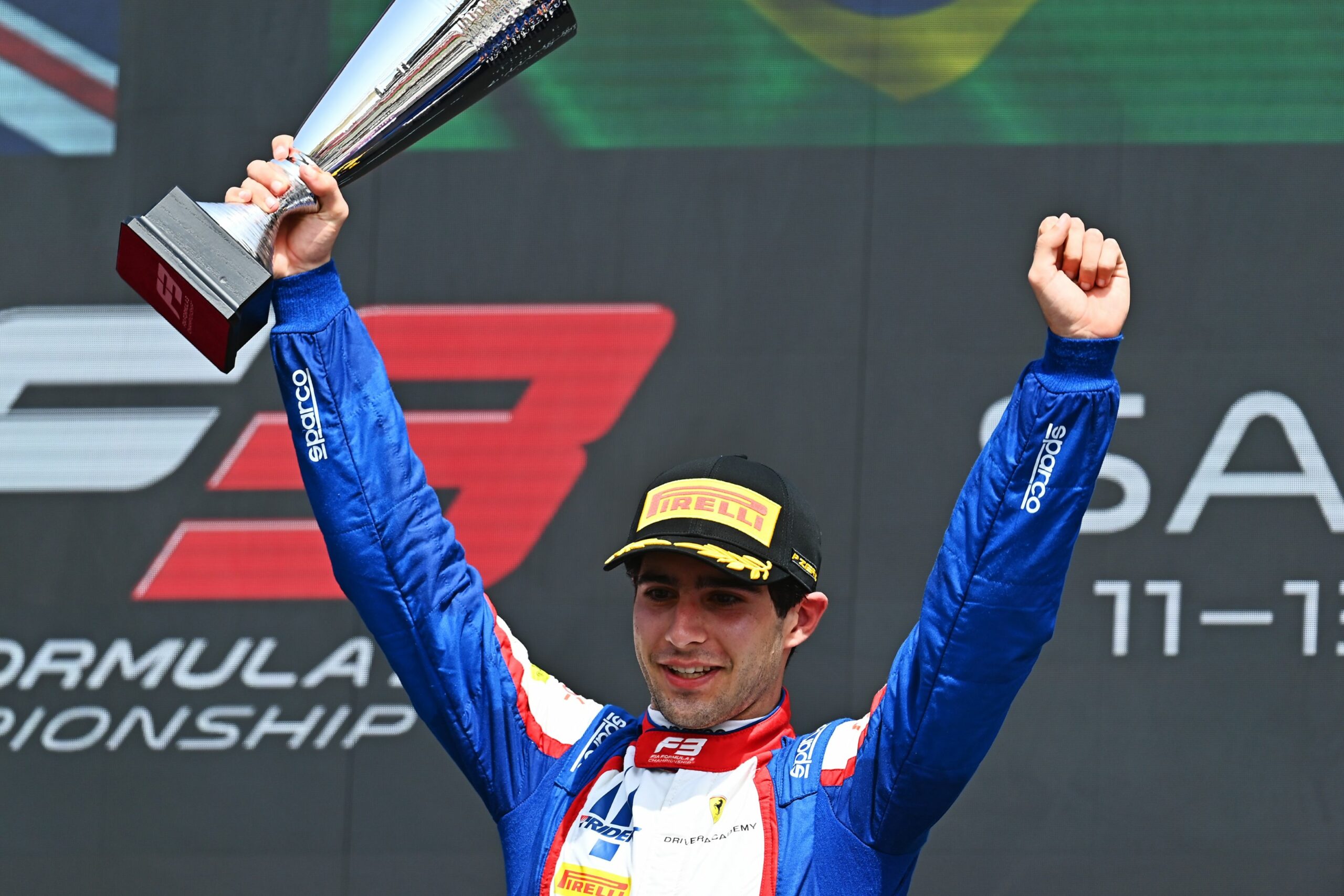British AIX Racing driver Freddie Slater had stunning F3 debut with a P2 finish in the Sprint Race at Bahrain GP. Strong of a recent in-season test at the Sakhir track last month, Slater drove an impressive from P3, finishing the race P2 behind Nikola Tsolov. The new AIX Racing driver is yet to be confirmed for the next round and is not guaranteed a seat for Imola.
An outstanding start to Slater’s F3 career
Incredibly pleased with today’s podium, Slater cited “a mega start, just for jumping into one race” when speaking to the media, including Pit Debrief at the F3 Post-Sprint Press Conference. The British driver thoroughly enjoyed his run. After leading the race at the beginning, Tsolov caught up to the Briton. A tense fight ensued, with Tsolov coming out on top. The 16-year-old driver hoped for another opportunity to overtake his rival, which unfortunately never arrived owing to several safety cars out on track.
“So, it was great fun out there as well, leading for a little bit, and then going to second and trying to reset everything so I could have another chance.
But unfortunately, a few safety cars affected that.”
Despite any challenges, the driver remained overwhelmingly positive about the experience, highlighting the overall progress made. He expressed sincere gratitude towards the team, particularly for the car they were provided with, which played a significant role in his performance.
“But no, overall, super, super positive. And a massive thank you to the team for the car they gave me.”
Heat and tyre degradation, a challenging combination for drivers
Bahrain’s scorching heat and abrasive tarmac made it incredibly hard for drivers during the Bahrain GP Sprint Race. On top of racing each other, the drivers had to manage their tyres to prevent degradation as well as avoid the dirty part of the track as Slater explained:
“Yeah, that’s what I was about to say, is we were having to race, but also manage the tyres and stay on the clean bit of track.
“So, the track was super dirty, super hot, so all the worst things for drivers.”
The young driver further expanded on the difficulty to handle these factors in addition to the racing itself, while having to maintain a secure gap to drivers at the back.
“I think the biggest thing is when we’re racing each other so hard, all the dirt on the tyres, that just makes it 10 times worse.
“So, we’re trying to race hard, keep the tyres clean and not lose too much pace to the people behind to keep the gap.”
Despite the challenge, Slater was elated by his results and the race overall.
“But we managed it well and had a good battle out there. And yeah, I really enjoyed the experience.”
A considerable learning experience for Slater
The new AIX Racing driver’s start in Formula 3 occurred in demanding yet formative conditions. Slater deems this first F3 experience in the Bahrain GP to be highly instructive. When asked how much he had learn, the British driver replied that it was “Huge, like, obviously I’ve learned the tyre management, the deg, especially in hot conditions, 38 degrees, with a 52-degree track temperature is insane.”
Already looking ahead, Slater explained: “And it’s, especially with these big, heavy cars now, it’s even more crucial to learn. So, it’s only going to make me better in the long run.”
Slater emphasized that this level of tyre degradation was “a 100%” unprecedented for him: “Even compared to the test, the deg was nowhere near what we were expecting.”
A fierce fight at the front
The front runners delivered a strong battle during the Sprint Race at the Bahrain GP, pulling clear of the rest of the field. As British driver Slater explained: “Because me and Nikola [Tsolov] had quite a nice gap.”
The AIX Racing driver had hoped to maintain that advantage and focus on his duel with Tsolov, who ultimately got the better of him. Reflecting on the challenging conditions, Slater said: “The goal for me was to try and keep the gap open to the others. Then we had more opportunities to fight, of course.”
“It’s super tough out there with the track conditions, but a good learning experience.”
Slater focused on FRECA despite Fe opportunity
Racing at the Bahrain GP with AIX Racing for the first time, the Briton expressed his gratitude for the opportunity to compete in Formula 3: “Of course, any experience you can get in the higher categories is always going to help you.”
AIX Racing’s newest addition reflected on how valuable this experience will be for his ongoing Formula Regional European Championship by Alpine (FRECA) campaign. He acknowledged that his step up to F3 for the Bahrain weekend was unexpected, but believes it will only strengthen his development as a driver. Despite the opportunity, his main focus remains on the remainder of his FRECA season..
“So, I’m fully focused on my FRECA season. It was a last-minute opportunity I got to come do this race.
“It was a bit last-minute, but I definitely grabbed it with both hands, that’s for sure.
“So no, my full focus is on FRECA and this is going to give me some more experience and more knowledge, which is always going to help. So no, like I say, full focus on FRECA.”
Slater “fully focused” despite dramatic end to race
After an unfortunate incident brought out the safety car late in the Bahrain GP Sprint Race, the final laps took a dramatic turn. A strong restart could have given Slater the opportunity he needed to challenge Tsolov for the lead. With much to prove and the chance to solidify his place in Formula 3, the restart carried significant weight for the Briton.
In response to a question by Pit Debrief about the tense closing stages, Slater elaborated on his confident mindset and how it influenced his approach in the high-pressure moment.
“I was full focused ahead,” he said, “I saw an opportunity and I knew as I was coming up to where the safety car turned the lights off, I knew this was my opportunity and I needed a good restart and I actually got a really good jump.”
Despite his strong start to the race, however, Slater did struggle with some factors from behind the wheel. He explained that these had included trouble with his tyres and the windy conditions around the Sakhir International Circuit.
“So just the tyre wasn’t quite big enough today.”
“It wasn’t a headwind. It was, unfortunately, a tailwind down the main straight. So, I think if there was a bit of a headwind there, I would have been able to have a bit more of a race into [Turn 1].
Despite this, however, the British talent did his best to maximise his gains around the track, especially after the final Safety Car period.
“But yeah, I knew the moment I was going for and I had to try and execute, but it just didn’t quite happen. But overall positive and a good safety car restart, which is the main thing.”
A clear attack from the beginning
Tyre strategy is always a crucial element in any race, with drivers needing to preserve pace for the long run. However, FRECA driver Slater approached the Bahrain GP Sprint Race with a clear plan in mind. Starting from third, the British driver aimed to make a quick getaway and take control early.
“I think we were all starting behind cars. We had to get on with it at the start. I basically knew what I had to do. I needed to get into the lead as soon as possible and that was the goal.”
Despite his early charge, Slater struggled to maintain the lead as the rough Bahrain surface led to a slower overall pace. He eventually came under pressure from an aggressive Tsolov, who began closing in.
“And then I tried to manage for as long as possible and then Nickola came up behind, was a little bit faster, maybe that phase where I was managing and then he got in front and we were managing more.”
Slater did have a moment of hope when he noticed Tsolov’s tyres beginning to degrade, but it was not enough to reclaim the top spot.
“And then we started to pick the pace up as I saw Nicola was starting to struggle.”
Reflecting on the chaotic nature of the race, which included two Safety Cars, Slater acknowledged that the interruptions forced a change in his approach.
“So, I think if it wasn’t such an interfered race, I think it would have been a different race in terms of strategy, the way I played it. But on those first two laps, you can’t mess about.
“You’ve got to get on with it. So, I had to attack and then manage from there.”
Navigating the challenges of radio communication in Sakhir Sprint
The driver-engineer relationship is a vital component in any racer’s success. However, with his time with the AIX Racing F3 team limited to Bahrain in-season testing and GP weekend, Slater did not have the opportunity to develop a strong relationship with his driver. This, he admitted, had added another layer of difficulty, with frequent radio messages making it harder to stay focused.
“Yeah, obviously jumping into a new team, it’s quite hard to get the engineer and the driver relationship quite good straight away.
“So, actually, through the race, it was kind of a radio communication where I was asking for a little bit less information. I was just focused on what I was doing that time in the race and managing what was happening in front and behind.”
Despite the challenge, the rookie acknowledged the importance of communication with his AIX Racing engineer and credited the team’s support for keeping him motivated throughout the race.
“So no, of course, it’s super important, the information you’re getting. And I got some really good information to pounce at the right time and manage at different points.
“And yeah, also some good encouragement out there, which is always nice.”
A known layout for Freddie Slater
A recurring challenge across all categories racing at the Bahrain GP has been the significant tyre degradation. While the Briton had the chance to experience this first-hand during testing of the new car at Sakhir last month, evolving track conditions added another layer of complexity. With multiple categories running throughout the weekend, the surface continued to change, putting the rookie’s adaptability to the test as he worked under unpredictable circumstances.
“Yeah, obviously, circuit knowledge was the main thing I was learning. That’s what I’ve taken from the tests and to hearing certain techniques to manage the degradation. But F3 is known for being different every time you go out on track.
“You know, you go out after F1, which is also a huge swing in track conditions. So, you’re always adapting. And I knew after the first two laps, the conditions were different to what they were in the test and qualifying, etc.
“So, you’re always adapting to the situation you’re in and that’s what we did then and managed to work out, yeah.”





